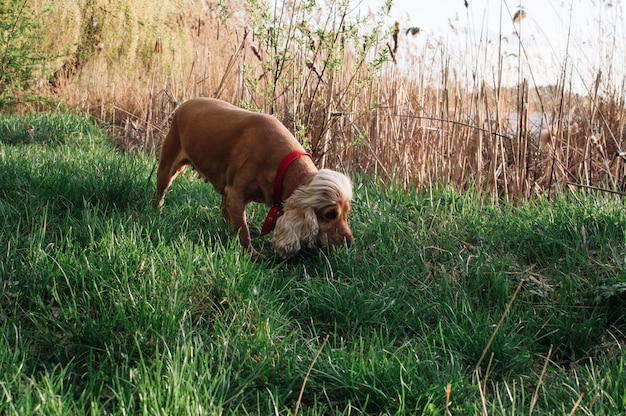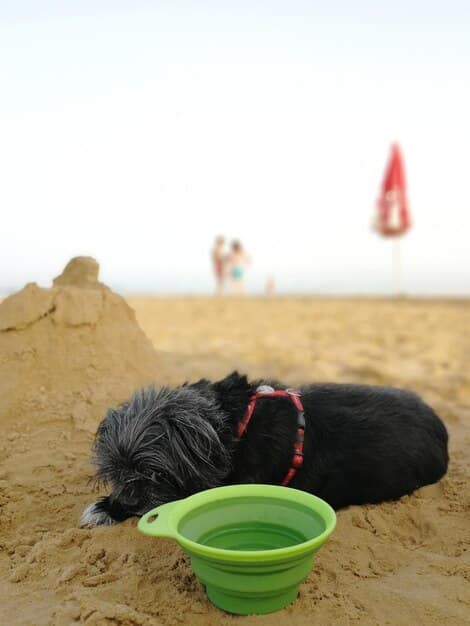Stop Dog Digging: Solve Your Yard Digging Dilemma!

Stop Dog Digging: Solve Your Yard Digging Dilemma This Season by understanding why dogs dig, providing appropriate outlets, and implementing training techniques to redirect the behavior.
Is your backyard looking more like a construction site than a peaceful retreat? The digging dilemma: stop your dog’s destructive digging in the yard this season can be a frustrating challenge for many dog owners. But fear not, with a little understanding and the right approach, you can curb this behavior and reclaim your outdoor space.
Understanding Why Your Dog Digs
To effectively address your dog’s digging habits, it’s crucial to first understand the underlying reasons behind this behavior. Digging isn’t always a sign of naughtiness; often, it’s a natural instinct or a response to specific needs or environmental factors.
Instinctual Behavior
For some breeds, digging is deeply ingrained in their DNA. Terriers, for example, were originally bred to hunt rodents and other small animals that live underground. As a result, they have a strong instinct to dig and explore.
Boredom and Anxiety
Dogs who are left alone for long periods without adequate mental or physical stimulation may turn to digging as a way to relieve boredom or anxiety. Digging provides an outlet for pent-up energy and can be a self-soothing behavior for anxious dogs.
- Provide plenty of exercise: Regular walks, runs, or play sessions can help burn off excess energy and reduce the urge to dig.
- Offer interactive toys: Puzzle toys, treat-dispensing toys, and chew toys can keep your dog mentally stimulated and entertained.
- Consider doggy daycare or a dog walker: Social interaction and structured activities can help alleviate boredom and anxiety.

Understanding the root cause of your dog’s digging is the first step towards finding a solution. By addressing the underlying reasons, you can create a more enriching environment for your furry friend and reduce the likelihood of destructive digging.
Creating a Designated Digging Area
One effective strategy for managing your dog’s digging is to provide them with a designated digging area. This allows them to indulge their natural instincts in a controlled environment, while also protecting the rest of your yard.
Choosing the Right Location
Select a spot in your yard that is away from gardens, walkways, and other areas you want to protect. Consider factors such as sunlight, drainage, and proximity to water sources.
Building Your Digging Pit
You can create a digging pit using a variety of materials, such as a kiddie pool, a sandbox, or a fenced-off area. Fill the pit with sand, soil, or a combination of both. You can also bury toys or treats in the pit to encourage your dog to use it.
- Make it inviting: Introduce your dog to the digging pit with enthusiasm and positive reinforcement. Bury their favorite toys or treats in the pit and praise them when they start to dig.
- Supervise their digging: Initially, supervise your dog while they are using the digging pit to ensure they understand that this is where they are allowed to dig.
- Maintain the pit: Regularly replenish the sand or soil in the pit and remove any debris.
By providing a designated digging area, you’re giving your dog an appropriate outlet for their natural digging instincts, while also protecting the rest of your yard from destruction. Consistency and positive reinforcement are key to success.

Training Techniques to Redirect Digging
In addition to providing a designated digging area, training techniques can be used to redirect your dog’s digging behavior. Consistent training and positive reinforcement can help your dog learn what is expected of them and reduce the urge to dig in unwanted areas.
“Leave It” Command
Teach your dog the “leave it” command. This command can be used to stop your dog from digging in areas where they are not allowed. When you see your dog starting to dig, say “leave it” in a firm voice and redirect their attention to something else.
Positive Reinforcement
Reward your dog with praise and treats when they obey the “leave it” command or when they choose to play with a toy instead of digging. Positive reinforcement helps your dog associate good behavior with positive outcomes.
- Consistency is key: Be consistent with your training and use the same commands and rewards every time.
- Be patient: It takes time and patience to train a dog to stop digging. Don’t get discouraged if you don’t see results immediately.
- Avoid punishment: Punishing your dog for digging can create fear and anxiety, which can actually worsen the problem.
Combining training techniques with a designated digging area can be a highly effective way to curb your dog’s digging behavior. Remember to be patient, consistent, and positive in your approach.
Addressing Boredom and Providing Enrichment
Boredom is a common trigger for digging, especially for dogs who are left alone for long periods. Providing adequate mental and physical stimulation can help reduce the urge to dig and keep your dog happy and engaged.
Interactive Toys and Games
Offer a variety of interactive toys and games to keep your dog entertained. Puzzle toys, treat-dispensing toys, and fetch games can provide mental stimulation and help burn off excess energy.
Regular Exercise
Make sure your dog gets plenty of exercise every day. Regular walks, runs, or play sessions can help reduce boredom and anxiety. The amount of exercise your dog needs will depend on their breed, age, and energy level.
- Rotate toys regularly: Keep your dog interested by rotating their toys every few days. This will make the toys seem new and exciting.
- Create a backyard obstacle course: Use household items such as cones, tunnels, and jumps to create a fun and challenging obstacle course for your dog.
- Teach your dog new tricks: Training can be a great way to bond with your dog and provide mental stimulation.
By addressing boredom and providing enrichment, you can create a more stimulating environment for your dog and reduce the likelihood of destructive digging. A happy and engaged dog is less likely to dig out of boredom.
Managing Environmental Factors
Environmental factors can also contribute to digging behavior. Dogs may dig to seek relief from heat or cold, or to find water. Managing these environmental factors can help reduce the urge to dig.
Providing Shade and Water
Make sure your dog has access to shade and fresh water, especially during hot weather. A dog house or covered area can provide protection from the sun. A water bowl should always be available and refilled regularly.
Protecting Against Cold
During cold weather, provide your dog with a warm and sheltered place to sleep. A dog house or insulated bed can help protect them from the cold. Limit their time outdoors during extreme cold.
- Consider the breed: Some breeds are more sensitive to heat or cold than others. Take your dog’s breed into account when managing environmental factors.
- Monitor the weather: Pay attention to the weather forecast and take steps to protect your dog from extreme temperatures.
- Provide cooling or heating pads: Cooling pads can help keep your dog cool during hot weather, while heating pads can provide warmth during cold weather.
By managing environmental factors, you can create a more comfortable and safe environment for your dog and reduce the urge to dig in response to temperature extremes.
When to Seek Professional Help
In some cases, digging may be a sign of a more serious behavioral problem, such as separation anxiety or obsessive-compulsive disorder. If you have tried the above strategies and your dog’s digging persists, it may be time to seek professional help.
Consulting a Veterinarian
Your veterinarian can help rule out any underlying medical conditions that may be contributing to your dog’s digging behavior. They can also recommend a qualified dog trainer or behaviorist.
Working with a Dog Trainer or Behaviorist
A dog trainer or behaviorist can help you develop a customized training plan to address your dog’s specific digging issues. They can also provide guidance on managing other behavioral problems.
- Look for a certified professional: Choose a dog trainer or behaviorist who is certified by a reputable organization.
- Be prepared to commit: Addressing behavioral problems takes time and effort. Be prepared to commit to the training plan and follow through with the recommendations.
- Don’t give up: With patience and persistence, you can help your dog overcome their digging issues and enjoy a happy and fulfilling life.
If you are struggling to manage your dog’s digging behavior on your own, don’t hesitate to seek professional help. A qualified professional can provide the guidance and support you need to address the problem effectively.
| Key Point | Brief Description |
|---|---|
| 🐾 Understand the Why | Determine if digging stems from instinct, boredom, or anxiety. |
| 🌳 Designated Zone | Create a specific area where digging is allowed, redirecting behavior. |
| 🎾 Enrichment is Key | Combat boredom with interactive toys and adequate exercise to reduce digging. |
| 🌡️ Manage Environment | Ensure access to shade and water to prevent digging due to heat or thirst. |
FAQ
▼
Sudden digging can be due to increased boredom, new environmental stressors, or changes in routine. Check for any recent disruptions or unmet needs.
▼
Bury toys and treats in the area, make it a soft and diggable texture, and consistently reward your dog when they use it.
▼
Increase enrichment activities before you leave, such as puzzle toys, and consider a dog walker or pet sitter to break up their day.
▼
Yes, sand is a great option, but ensure it’s clean and free of sharp objects. Avoid using sand that can clump or become too dusty.
▼
It varies depending on the dog and the consistency of training. It can take several weeks to months to see a significant change in behavior.
Conclusion
Dealing with a dog who loves to dig requires patience, understanding, and a proactive approach. By understanding the reasons behind the behavior, providing appropriate outlets, implementing training techniques, and managing environmental factors, you can effectively address the digging dilemma: stop your dog’s destructive digging in the yard this season and enjoy a harmonious outdoor space with your furry friend.





